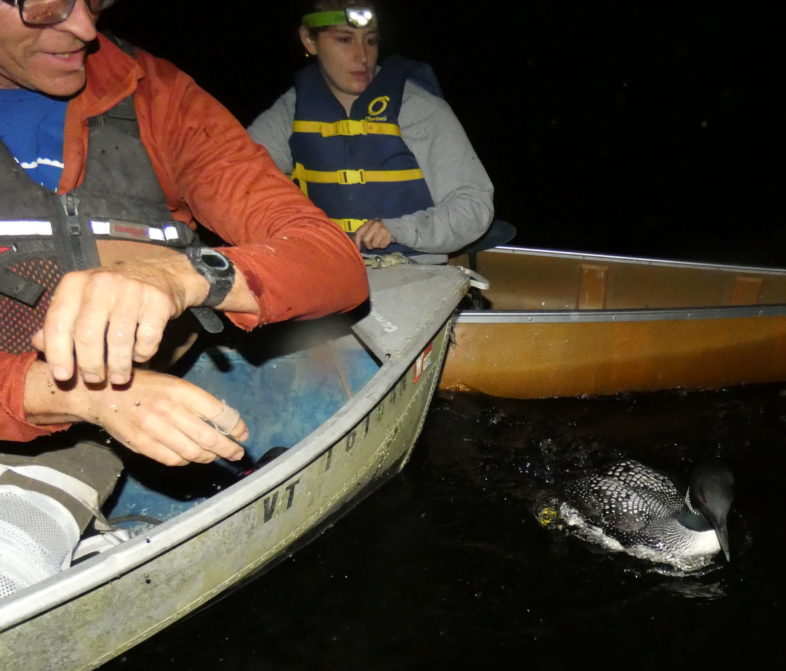
A male loon paddles off to rejoin his chick after being banded. © Kata Gilbertson
Darkness enveloped the shoreline of Holland Pond as I lowered my net into the canoe. I checked my watch—9:40 pm. Less than an hour ago, VCE’s loon banding team had spotted an adult loon and chick paddling towards the pond’s north end. With the last pieces of gear stowed safely in our boats, we turned on our spotlights, aiming them at the pond. Carefully, we scoured its glassy surface for black shadows flecked with white. After several long moments of searching, one of our team members softly called out, pointing just left of where we spotted the loons earlier. It was time to get moving.
Unfortunately, relocating the loons was only half our battle during our two-day expedition to sample and band loons as part of several North America-wide studies. Unlike laboratory experiments, a field-based research project’s success is often at the whims of variables outside the researcher’s control. Despite our best preparations, surprise turns in weather, unexpectedly rough terrain, and countless other factors can determine whether or not researchers can collect vital data. In this case, the success of our study rode on one element in particular: we actually had to catch a loon.
VCE seasonal biologist Eloise Girard and I led our crew of six as we followed our beam of light out towards the birds. The adult loon swam slowly back and forth as we approached, mesmerized by our lights. I lunged when we were within 10 feet, hoping for an easy capture. However, nerves and lack of catching practice made me fumble my net, and I missed, causing the loon to wing-row away from us. We backed off for 10 minutes to wait for the adult to return to the chick and crossed our fingers that the bird would offer another chance. This time, I held off until the chick and adult drifted within 6 feet of us. Eloise steered the boat perfectly, and when the adult turned towards us, I shoved the net into the water and lifted—capture!
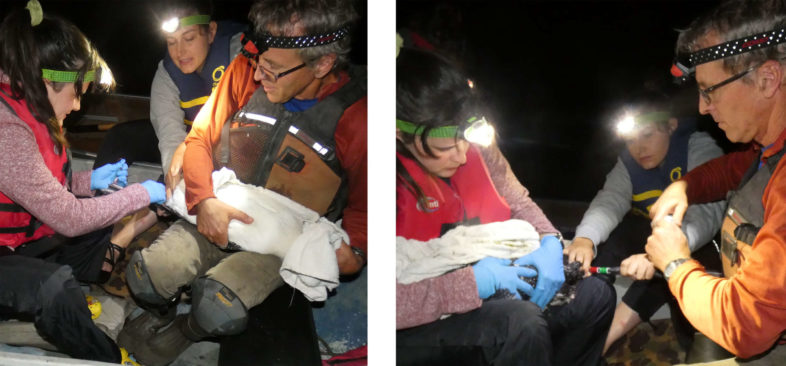
Left: Toni (left) draws a blood sample from the loon’s leg while Karli (middle) and I keep him secure. Right: Toni and Karli hold the loon steady while I band (red over green). © Kata Gilbertson
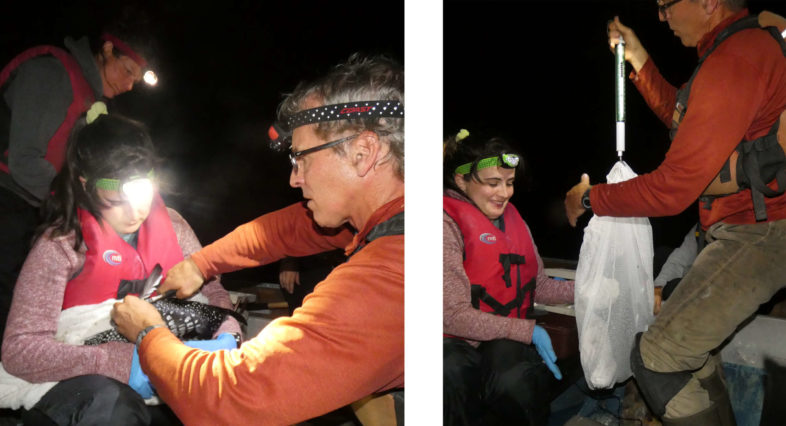
Left: Toni holds the loon while I take a feather sample. Right: We weigh the loon before letting him rejoin his chick on the pond. © Kata Gilbertson
Once the netted loon was safely onboard, Tufts graduate student and Loon Preservation Committee (LPC) seasonal biologist Toni Rabasco quickly secured the bird’s wings and feet before gently wrapping a towel around his head. Once we had the loon extracted, I held him like a giant rugby ball while Toni took bill measurements and a blood sample from a leg vein, and Karli Fletcher (a first-year vet student at Tufts) held his feet and bill as needed. Finally, I banded him, took some feather samples, and obtained a weight before releasing him. We determined it was a “him” based on his weight since males are heavier than females by about 20–30%. This individual weighed a whopping 5650 grams (or about 12.5 lbs). The chick was hiding in a cove nearby, so we let the male and chick reunite before returning to the boat access. We suspected the female was likely nearby because we heard other loons calling; however, she chose not to join our adventure.
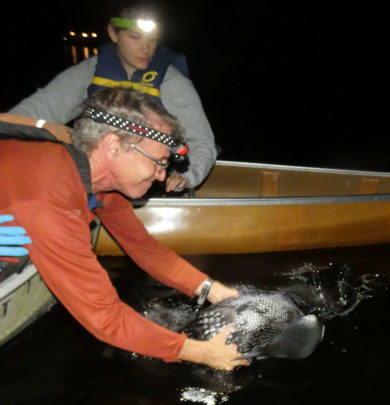
The Holland Pond loon is released and quickly paddles away. © Kata Gilbertson
After Holland Pond, we set off for Derby Pond and arrived around midnight. However, luck wasn’t on my side this time, and I wasn’t on the right side of the boat. The first adult loon swam off to the left in front of the canoe; I was netting from the other side. Despite my disadvantage, I decided to attempt a catch anyway. The distance allowed the bird an extra split second to splay its wings and push off from the net rim. Another opportunity gone. The second adult also gave us a good chance to catch it but pulled a similar maneuver. Instead of doing its “normal” dive when the net submerged, this loon stayed on the surface and skedaddled away. We could have kept trying and likely would have caught at least one adult, but one of our goals is to avoid causing unnecessary agitation. Over the past decade, Derby Pond has only had a few chicks, so we decided to leave the birds be. Maybe next year.
After five hours of sleep and multiple cups of coffee, we headed to the Barton Veterinary Hospital, operated by veteran Crystal Lake loon volunteers Judy Robitaille-Dunklee and Stan Dunklee. Toni had joined us from LPC in New Hampshire to train Eloise, Karli, and me on how to process loon blood samples. We passed the remaining daylight hours dividing samples for various groups and spinning them down to assess packed red blood cell counts and conduct plasma tests.
After a long day in the lab, our team was ready for our second night on the water. We convened at Ewell Pond in Peacham later that evening, where we were joined by VCE Director of Conservation Science Ryan Rebozo and one of the pond volunteers Melody Morrison and her three grandchildren. This time, the loons had clearly read the methodology section in Loon Capture and Banding Technique and cooperated. We quickly located one adult with two chicks and made our approach. The birds couldn’t see the boat and swam quietly in our spotlight beam. As we closed in, the adult glided toward the light, and I plunged my net into the water, capturing it within seconds. One chick also snuck into the net, so we quickly separated it from the adult. Ryan kept an eye on the other chick, allowing us to track it down with our lights. We were astounded to witness this two-week-old chick swimming over 20 feet underwater horizontally! Eloise kept the boat right with it as we followed. Once it surfaced, we gently netted the little bird for some measurements.
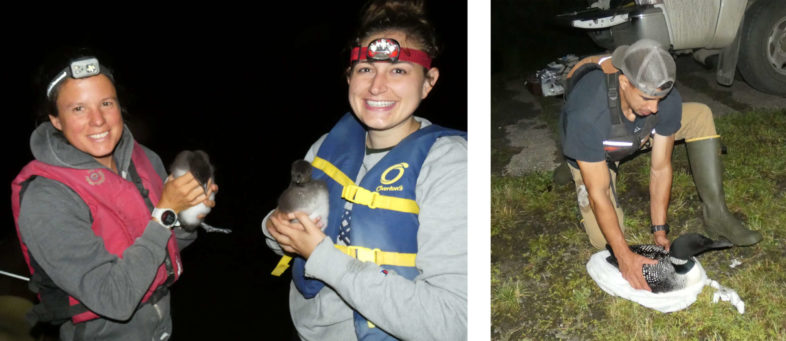
Left: Eloise (left) and Karli pause with the chicks. Right: Ryan prepares to release the adult loon.
With all three loons captured, we began gathering data. Karli drew blood from her first loon ever (I bet it won’t be her last!), Eloise took measurements and put on bands, and Ryan released the birds. The three Morrison kids were in charge of keeping an eye on the chicks in the chick box; they also had a chance to pet the chicks before release. After all the excitement was over at 11 pm, Natalie (age 4) gave a big yawn. Despite a little adrenaline rush from the capture, a few others were yawning too, and we all headed gratefully to bed.
As loon banders, we hope for nights like the one we had on Ewell Pond; however, we’ll always have birds like the ones on Derby Pond. This data we collected, along with data from studies conducted in Maine to New York, Wisconsin, Minnesota, Montana, and Washington, will help guide future research, as well as conservation actions and emissions policies. Our work in Vermont may only contribute a few tiny data points, but data points add up to patterns and results that help form a bigger picture of loon population health and behavior across their North American range.
If you want to learn more about our Vermont Loon Conservation Project (VLCP) and find out how you can help monitor Vermont’s loons, please visit the VLCP homepage.
Kata Gilbertson, a high school student and volunteer from Green River Reservoir, took most of the photos from Holland Pond. Her father, Marc, tagged along. Marc is a college classmate of mine from Colby College, now a school teacher and a former Olympic cross country skier. He helped with some loon captures back in 2001 and 2002.
